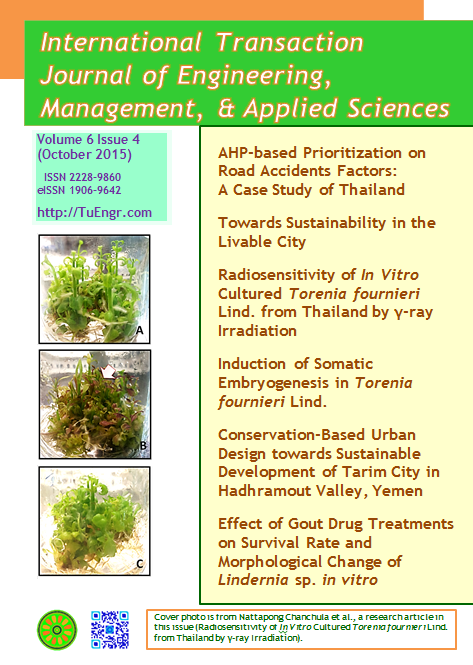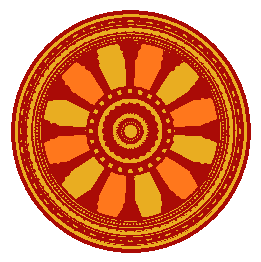- AHP-based Prioritization on Road Accidents Factors: A Case Study of Thailand
 Warich Temrungsie, Winai Raksuntron (Department of Civil Engineering, Faculty of Engineering, Thammasat University, THAILAND ), Sanya Namee (Department of Disaster Prevention and Mitigation, Ministry of Interior, THAILAND), Songrit Chayanan (Bureau of Highway Safety, Department of Highways, THAILAND), and Boonsap Witchayangkoon (Department of Civil Engineering, Faculty of Engineering, Thammasat University, THAILAND )
Warich Temrungsie, Winai Raksuntron (Department of Civil Engineering, Faculty of Engineering, Thammasat University, THAILAND ), Sanya Namee (Department of Disaster Prevention and Mitigation, Ministry of Interior, THAILAND), Songrit Chayanan (Bureau of Highway Safety, Department of Highways, THAILAND), and Boonsap Witchayangkoon (Department of Civil Engineering, Faculty of Engineering, Thammasat University, THAILAND )
(mirror)
doi: 10.14456/itjemast.2015.10
Keywords:
Analytic Hierarchy Process;
Questionnaire;
Pairwise comparison.
Abstract
As Analytic Hierarchy Process (AHP) being to handle multi-criteria analysis for complex decision making, AHP has been used as a study tool to learn and prioritize information that could prevent and reduce accidents. Information is obtained from questionnaire with one hundred respondents. Criteria and sub-criteria are adapted from White Paper for Safe Roads in 2050 of UN (2010). Four criteria include factors pertinent to 1) engineering (sub-criteria: road geometries, traffic signs, traffic signals, and rainwater drainage), 2) economics (sub-criteria: cost-effective road safety investments, cost-effective auto maintenance investments, and cost-effective road maintenance investments), 3) environmental and social (sub-criteria: medical service, quality of life, public transportation, and bicycle commuting), and 4) safety management (sub-criteria: law enforcement, quality of accident data, and road users’ knowledge of road rules). Respondents are selected groups of policemen, health care staffs (physicians and nurses), highway department personnel, academic and engineering staffs, and people in general. The questionnaire survey applies pairwise comparison, to study attitudes/preferences of respondents regarding accident factors of these criteria and sub-criteria. From AHP analysis, safety management factor is ordered first in the prioritization of this study. This agrees with AHP sub-criterion analysis that the most prioritized factors are law enforcement and knowledge of road rules, respectively.
- Towards Sustainability in the Livable City
 Walaa Nour (Department of Architectural Engineering and Building Technology, Faculty of Engineering, Modern Academy for Engineering and Technology, EGYPT )
Walaa Nour (Department of Architectural Engineering and Building Technology, Faculty of Engineering, Modern Academy for Engineering and Technology, EGYPT )
(mirror)
doi: 10.14456/itjemast.2015.9
Keywords:
Desert communities
Regional planning;
Urban planning strategy
Abstract
When livability became the key word for our regional planning, we knew we would have to find effective ways to deal with many problems, producing a plan and regulations would not be enough. We had to deal with long-term future livability, but also with people's ongoing satisfaction, their day-to-day experience of living in the region. Tomorrow's livability needed as much attention as the attainment of a better future. Hence, the aim of this paper is to present the history and evolution in thinking within planning for the greater Vancouver area and making cities more livable: ideas and action.
- Radiosensitivity of In Vitro Cultured Torenia fournieri Lind. from Thailand by γ-ray Irradiation
 Nattapong Chanchula (Department of Horticulture, Faculty of Agriculture, Kasetsart University, THAILAND), Thunya Taychasinpitak * (Department of Horticulture, Faculty of Agriculture, Kasetsart University, THAILAND and Center for Advanced Studies for Agriculture and Food, Kasetsart University, THAILAND),
Anchalee Jala, Theerachai Thanananta (Department of Biotechnology, Faculty of Science and Technology, Thammasat University, THAILAND ) and Shinji Kikuchi (Department of Horticulture, Faculty of Horticulture, Chiba University, JAPAN )
Nattapong Chanchula (Department of Horticulture, Faculty of Agriculture, Kasetsart University, THAILAND), Thunya Taychasinpitak * (Department of Horticulture, Faculty of Agriculture, Kasetsart University, THAILAND and Center for Advanced Studies for Agriculture and Food, Kasetsart University, THAILAND),
Anchalee Jala, Theerachai Thanananta (Department of Biotechnology, Faculty of Science and Technology, Thammasat University, THAILAND ) and Shinji Kikuchi (Department of Horticulture, Faculty of Horticulture, Chiba University, JAPAN )
(mirror)
doi: 10.14456/itjemast.2015.8
Keywords:
Axillary bud;
Gamma irradiation;
Tissue culture;
Mutation breeding; Ornamental breeding
Abstract
Gamma ray irradiation is a conventional technique used to produce mutants in plant breeding. The aim in this research was to develop new cultivars of Torenia (Linderniaceae) for the ornamental market. Leaves of Torenia fournieri Lind. were exposed to acute (Cs-137) gamma ray irradiation at 0, 20, 40, 60, 80, 100 and 120 grays. After culturing, the number of plantlets, plant height and root length of surviving plants was measured 60 d after irradiation. The results showed that the LD50 was 63.65 grays in diploid plants and 72.00 grays in polyploid plants. Red colored leaves were observed in some plants after acute gamma irradiation treatment, for example in the 20-gray treatment group for diploid Torenia and in the 80-gray treatment group for polyploid Torenia. The plants with red leaves were selected for development in the future.
- Induction of Somatic Embryogenesis in Torenia fournieri Lind.
 Nattapong Chanchula, Thunya Taychasinpitak * (Department of Horticulture, Faculty of Agriculture, Kasetsart University, THAILAND)
Anchalee Jala, Theerachai Thanananta (Department of Biotechnology, Faculty of Science and Technology, Thammasat University, THAILAND ) and Shinji Kikuchi (Department of Horticulture, Faculty of Horticulture, Chiba University, JAPAN )
Nattapong Chanchula, Thunya Taychasinpitak * (Department of Horticulture, Faculty of Agriculture, Kasetsart University, THAILAND)
Anchalee Jala, Theerachai Thanananta (Department of Biotechnology, Faculty of Science and Technology, Thammasat University, THAILAND ) and Shinji Kikuchi (Department of Horticulture, Faculty of Horticulture, Chiba University, JAPAN )
(mirror)
doi: 10.14456/itjemast.2015.7
Keywords:
embryogenic callus;
tissue culture;
young leaves;
picloram;
in vitro .
Abstract
Somatic embryogenesis is one biotechnological method that can be used to produce genetically identical plants for use in plant breeding. In this research, we attempted to induce the formation of embryogenic callus from young leaves excised from in vitro Torenia spp. by culturing in the dark for 1, 2, 3 and 4 weeks on Murashige and Skoog (MS) medium with Picloram solution added at the concentrations of 0.5, 1, 1.5 and 2 mg-1 and 2,4-D solution added at the concentrations of 0.5, 1, 1.5 and 2 mg-1. The leaf explants from all the 2,4-D treatments turned brown and died, but the leaf explants cultured on media with Picloram added at every concentration tested formed soft, loosely aggregated callus tissue. Callus tissue was induced from leaves of diploid Torenia to the greatest degree (95% callus formation at 3 weeks) when cultured on MS medium containing Picloram at 1.5 mg-1 in the dark, and callus tissue tended to turn brown with increasing Picloram concentration and increasing incubation time. For polyploid Torenia, the highest percentage of callus formation was observed on leaves cultured on MS medium containing Picloram, and callus tissue also tended to turn brown with increasing Picloram concentration and increasing incubation time. Following transfer of the embryogenic callus tissue to hormone-free MS medium under light conditions (16-h photoperiod), the greatest rate of somatic embryo formation was observed, in case of both diploid and polyploid Torenia accessions.
- Conservation-Based Urban Design Towards Sustainable Development of Tarim City in Hadhramout Valley, Yemen
 Anwar Ahmed Baeissa * (Department of Architecture & Environmental Planning, Faculty of Engineering & Petroleum, Hadhramout University, YEMEN)
Anwar Ahmed Baeissa * (Department of Architecture & Environmental Planning, Faculty of Engineering & Petroleum, Hadhramout University, YEMEN)
(mirror)
doi: 10.14456/itjemast.2015.6
Keywords:
Architectural-Heritage; Rehabilitation;
Restoration Heritage Palaces;
Asian architecture
Abstract
The Old Hadhrami Cities such as Tarim city boasts many superior palaces shared in built between the Hadhrami architectural style and the Asian constructions. The limited use of local building materials in the city's architecture of mud clearly shows the active participation of the inhabitants in determining the quality of the architectural heritage which emanates their social traditions and customs. This technique using local materials in building construction gives the city a distinguished position among all cities in the region. The work focuses on the score force available-facilities of urban development and conservation of the city in all of the land space available for sustainable development in the city and some services of renovation projects to meet the needs of inhabitants. Mosques, mud houses and schools all these together constitute a unique identity in the settlement of the city through available of main network and secondary roads on the periphery of the city. All aspects of urban renovation for the case study collaborate in improving the economic situation of this region and reinforce it with services and link it with the other surrounding regions for tourism investment which is considered a substitute for industrial and artisan investment in the heritage environment. The increasing consciousness of inhabitants on heritage environment supports the conservation of these historical cities and as a result, encourages the inhabitants to settle in this area, and finally to search for guidelines of the sustainable city’s development through the existence of squares and empty spaces which serve meeting the needs of the visitors of the city.
- Effect of Gout Drug Treatments on Survival Rate and Morphological Change of Lindernia sp. in vitro
 Kamontip Sungkaew, Thunya Taychasinpitak* , Shermarl Wongchaochant, (Department of Horticulture, Faculty of Agriculture, Kasetsart University, THAILAND) Patana Sukprasert (Department of Agricultural Extension and Communication, Faculty of Agriculture, Kasetsart University, Bangkok 10900 THAILAND ) and Shinji Kikuchi (Department of Horticulture, Faculty of Horticulture, Chiba University, JAPAN )
Kamontip Sungkaew, Thunya Taychasinpitak* , Shermarl Wongchaochant, (Department of Horticulture, Faculty of Agriculture, Kasetsart University, THAILAND) Patana Sukprasert (Department of Agricultural Extension and Communication, Faculty of Agriculture, Kasetsart University, Bangkok 10900 THAILAND ) and Shinji Kikuchi (Department of Horticulture, Faculty of Horticulture, Chiba University, JAPAN )
(mirror)
doi: 10.14456/itjemast.2015.5
Keywords:
Linderniaceae;
Plant Mutation;
Tissue culture;
Colchicine treatment
Abstract
This research created greater genetic variation in Lindernia sp. by studying the most appropriate concentration and duration of colchicine treatment that could induce polyploidy in Lindernia sp. Leaf and node sections taken from 1-month old Lindernia plants grown in vitro were used as the explants to be immersed in colchicine solution at the concentrations of 0, 5, 10, 15 and 20 ppm for 1, 2 and 3 days. The experiment was a 5×3 Factorial in CRD with 10 replications and 2 explants per replication. The results showed that the plants regenerated from the colchicine-treated node and leaf sections had lower survival rate, shorter plant height, shorter internode length, fewer roots and shorter roots than the control group, with an increasing effect from increased concentrations of colchicine and increased exposure time; but the colchicine-treated plants had thicker stems, thicker roots and wider and longer leaves than the control. The treatment group exposed to colchicine at the concentration of 10 ppm for 3 days had the lowest survival rate (60% for node sections and 50% for leaf sections), but the highest polyploidy induction rate at 22.00% for node sections and 16.22% for leaf sections. The frequency of polyploidy induction was higher in node sections than in leaf sections, and the plants regenerated from node sections were also stronger and had a higher survival rate when planted out than those regenerated from leaf sections.

 Read full issue
Read full issue

 Warich Temrungsie, Winai Raksuntron (Department of Civil Engineering, Faculty of Engineering, Thammasat University, THAILAND ), Sanya Namee (
Warich Temrungsie, Winai Raksuntron (Department of Civil Engineering, Faculty of Engineering, Thammasat University, THAILAND ), Sanya Namee ( Walaa Nour (Department of Architectural Engineering and Building Technology, Faculty of Engineering, Modern Academy for Engineering and Technology, EGYPT )
Walaa Nour (Department of Architectural Engineering and Building Technology, Faculty of Engineering, Modern Academy for Engineering and Technology, EGYPT )
 Nattapong Chanchula (Department of Horticulture, Faculty of Agriculture, Kasetsart University, THAILAND), Thunya Taychasinpitak * (Department of Horticulture, Faculty of Agriculture, Kasetsart University, THAILAND and Center for Advanced Studies for Agriculture and Food, Kasetsart University, THAILAND),
Anchalee Jala, Theerachai Thanananta (Department of Biotechnology, Faculty of Science and Technology, Thammasat University, THAILAND ) and Shinji Kikuchi (Department of Horticulture, Faculty of Horticulture, Chiba University, JAPAN )
Nattapong Chanchula (Department of Horticulture, Faculty of Agriculture, Kasetsart University, THAILAND), Thunya Taychasinpitak * (Department of Horticulture, Faculty of Agriculture, Kasetsart University, THAILAND and Center for Advanced Studies for Agriculture and Food, Kasetsart University, THAILAND),
Anchalee Jala, Theerachai Thanananta (Department of Biotechnology, Faculty of Science and Technology, Thammasat University, THAILAND ) and Shinji Kikuchi (Department of Horticulture, Faculty of Horticulture, Chiba University, JAPAN )
 Nattapong Chanchula, Thunya Taychasinpitak * (Department of Horticulture, Faculty of Agriculture, Kasetsart University, THAILAND)
Anchalee Jala, Theerachai Thanananta (Department of Biotechnology, Faculty of Science and Technology, Thammasat University, THAILAND ) and Shinji Kikuchi (Department of Horticulture, Faculty of Horticulture, Chiba University, JAPAN )
Nattapong Chanchula, Thunya Taychasinpitak * (Department of Horticulture, Faculty of Agriculture, Kasetsart University, THAILAND)
Anchalee Jala, Theerachai Thanananta (Department of Biotechnology, Faculty of Science and Technology, Thammasat University, THAILAND ) and Shinji Kikuchi (Department of Horticulture, Faculty of Horticulture, Chiba University, JAPAN )
 Anwar Ahmed Baeissa * (Department of Architecture & Environmental Planning, Faculty of Engineering & Petroleum, Hadhramout University, YEMEN)
Anwar Ahmed Baeissa * (Department of Architecture & Environmental Planning, Faculty of Engineering & Petroleum, Hadhramout University, YEMEN)
 Kamontip Sungkaew, Thunya Taychasinpitak* , Shermarl Wongchaochant, (Department of Horticulture, Faculty of Agriculture, Kasetsart University, THAILAND) Patana Sukprasert (Department of Agricultural Extension and Communication, Faculty of Agriculture, Kasetsart University, Bangkok 10900 THAILAND ) and Shinji Kikuchi (Department of Horticulture, Faculty of Horticulture, Chiba University, JAPAN )
Kamontip Sungkaew, Thunya Taychasinpitak* , Shermarl Wongchaochant, (Department of Horticulture, Faculty of Agriculture, Kasetsart University, THAILAND) Patana Sukprasert (Department of Agricultural Extension and Communication, Faculty of Agriculture, Kasetsart University, Bangkok 10900 THAILAND ) and Shinji Kikuchi (Department of Horticulture, Faculty of Horticulture, Chiba University, JAPAN )